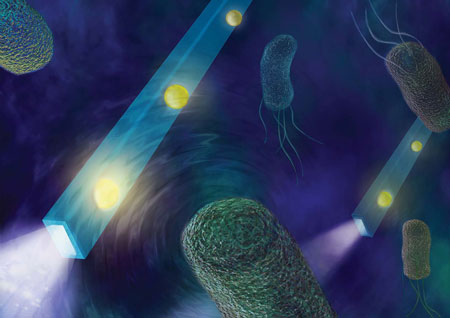| Posted: May 15, 2017 |
Nanofiber feels forces and hears sounds made by cells
(Nanowerk News) Engineers at the University of California San Diego have developed a miniature device that’s sensitive enough to feel the forces generated by swimming bacteria and hear the beating of heart muscle cells.
|
|
The device is a nano-sized optical fiber that’s about 100 times thinner than a human hair. It can detect forces down to 160 femtonewtons — about ten trillion times smaller than a newton — when placed in a solution containing live Helicobacter pylori bacteria, which are swimming bacteria found in the gut. In cultures of beating heart muscle cells from mice, the nano fiber can detect sounds down to -30 decibels — a level that’s one thousand times below the limit of the human ear.
|
|
“This work could open up new doors to track small interactions and changes that couldn’t be tracked before,” said nanoengineering professor Donald Sirbuly at the UC San Diego Jacobs School of Engineering, who led the study.
|
|
Some applications, he envisions, include detecting the presence and activity of a single bacterium; monitoring bonds forming and breaking; sensing changes in a cell’s mechanical behavior that might signal it becoming cancerous or being attacked by a virus; or a mini stethoscope to monitor cellular acoustics in vivo.
|
 |
| An artist’s illustration of nano optical fibers detecting femtonewton-scale forces produced by swimming bacteria. (Image: Rhett S. Miller/UC Regents)
|
|
The work is published in Nature Photonics ("Nanofibre optic force transducers with sub-piconewton resolution via near-field plasmon-dielectric interactions").
|
|
The optical fiber developed by Sirbuly and colleagues is at least 10 times more sensitive than the atomic force microscope (AFM), an instrument that can measure infinitesimally small forces generated by interacting molecules. And while AFMs are bulky devices, this optical fiber is only several hundred nanometers in diameter. “It’s a mini AFM with the sensitivity of an optical tweezer,” Sirbuly said.
|
|
The device is made from an extremely thin fiber of tin dioxide, coated with a thin layer of a polymer, called polyethylene glycol, and studded with gold nanoparticles. To use the device, researchers dip the nano optical fiber into a solution of cells, send a beam of light down the fiber and analyze the light signals it sends out. These signals, based on their intensity, indicate how much force or sound the fiber is picking up from the surrounding cells.
|
|
“We’re not just able to pick up these small forces and sounds, we can quantify them using this device. This is a new tool for high resolution nanomechanical probing,” Sirbuly said.
|
|
Here’s how the device works: as light travels down the optical fiber, it interacts strongly with the gold nanoparticles, which then scatter the light as signals that can be seen with a conventional microscope. These light signals show up at a particular intensity. But that intensity changes when the fiber is placed in a solution containing live cells. Forces and sound waves from the cells hit the gold nanoparticles, pushing them into the polymer layer that separates them from the fiber’s surface. Pushing the nanoparticles closer to the fiber allows them to interact more strongly with the light coming down the fiber, thus increasing the intensity of the light signals. Researchers calibrated the device so they could match the signal intensities to different levels of force or sound.
|
|
The key to making this work is the fiber’s polymer layer. It acts like a spring mattress that’s sensitive enough to be compressed to different thicknesses by the faint forces and sound waves produced by the cells. And Sirbuly says the polymer layer can be tuned — if researchers want to measure larger forces, they can use a stiffer polymer coating; for increased sensitivity, they can use a softer polymer like a hydrogel.
|
|
Moving forward, researchers plan to use the nano fibers to measure bio-activity and the mechanical behavior of single cells. Future works also includes improving the fibers’ “listening” capabilities to create ultra-sensitive biological stethoscopes, and tuning their acoustic response to develop new imaging techniques.
|

